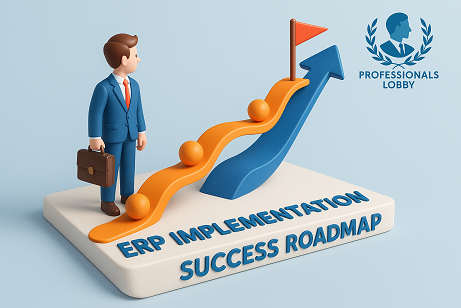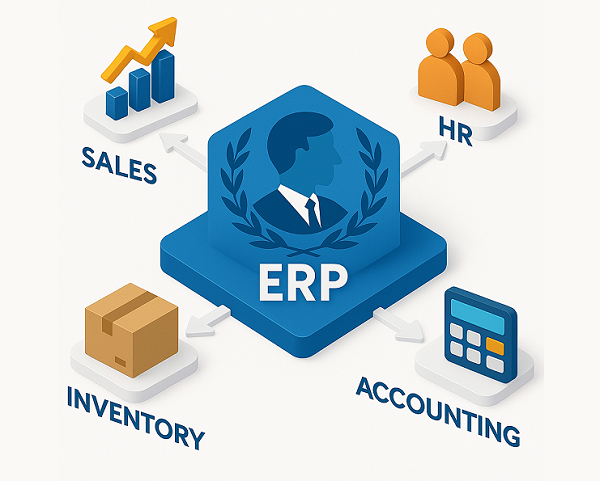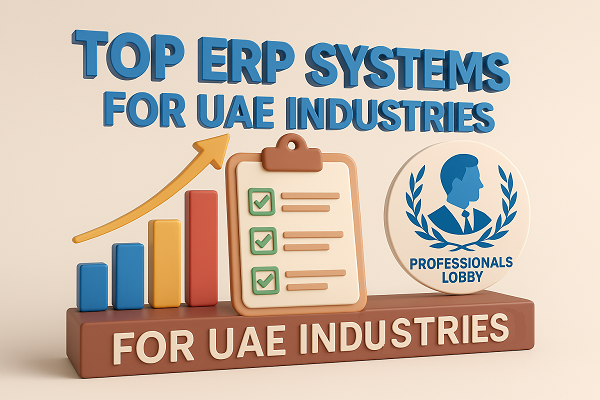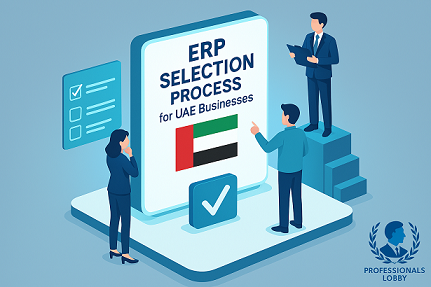Implementing an Enterprise Resource Planning (ERP) system is one of the most significant digital transformations a business can undertake. Based on our experience with hundreds of successful ERP implementations across the UAE, Professionals Lobby has developed this comprehensive guide to ensure your ERP project delivers maximum business value.
Quick Navigation
ERP Implementation Statistics
1. Comprehensive Planning Phase
The foundation of every successful ERP implementation is meticulous planning. Our consultants emphasize these critical planning components:
Define Clear Business Objectives
- Document specific pain points the ERP should address
- Establish measurable success criteria (KPIs)
- Align ERP goals with overall business strategy
Assemble the Right Team
- Executive sponsor (C-level champion)
- Project manager with ERP experience
- Departmental super-users
- IT infrastructure specialists
UAE Consideration: Include Arabic/English bilingual team members for regional implementations.
Develop Realistic Timeline
- Phase the implementation by priority modules
- Build in buffer time for testing and training
- Align with business cycles (avoid fiscal year-end)
Budget for Hidden Costs
- Customizations and integrations
- Data migration and cleansing
- Training and change management
- Post-go-live support
Typical Budget Allocation: 30% software, 50% services, 20% contingency
2. Master Data Preparation
Data quality directly determines ERP success. Our methodology ensures your data is implementation-ready:
Data Assessment
Analyze current data structures, quality, and completeness across all systems
Cleansing
Remove duplicates, standardize formats, and fill missing values
Restructuring
Align data models with new ERP requirements and hierarchies
Validation
Verify accuracy through sampling and business user review
Customer Data
- Classification by segment
- Credit terms verification
- Tax registration details
Product Data
- Standardized SKUs
- Complete attribute sets
- Barcode/GTIN compliance
Financial Data
- Chart of accounts mapping
- Opening balances
- Cost center structure
Inventory Data
- Accurate stock counts
- Warehouse locations
- Batch/serial tracking
Case Study: UAE Trading Company
A Dubai-based trading firm reduced ERP implementation time by 40% by completing data cleansing before vendor selection. Our team helped them:
- Consolidate 12,000 customer records into 8,500 clean entries
- Standardize 15,000 SKUs with proper categorization
- Validate all UAE VAT registration numbers
Result: Smooth data migration completed in 3 days instead of the projected 3 weeks.
3. Business Process Alignment
ERP success requires aligning software capabilities with your operational workflows:
Current State Documentation
Map all existing business processes with roles, systems, and pain points
Future State Design
Redesign processes leveraging ERP best practices and UAE compliance
Gap Analysis
Identify where customization is truly needed vs. adopting standard processes
Approval Workflows
Configure multi-level approvals based on UAE business hierarchies
UAE-Specific Process Considerations
VAT Compliance
Ensure all financial processes comply with FTA requirements
Bilingual Support
Arabic/English document generation and reporting
Hijri/Gregorian
Dual calendar support for all date-sensitive processes
HR Policies
Configure UAE labor law and gratuity calculations
4. Comprehensive Testing Approach
Thorough testing prevents post-implementation surprises. Our layered testing methodology:
Unit Testing
- Individual module verification
- Basic functionality checks
- Developer-led validation
Integration Testing
- Cross-module process flows
- Interface validation
- Data consistency checks
User Acceptance Testing
- Real business scenarios
- Departmental super-users
- Sign-off before go-live
Performance Testing
- Load testing with concurrent users
- Transaction volume simulation
- Response time benchmarks
Critical Test Cases for UAE Businesses
VAT Calculation
Verify correct tax treatment for all transaction types
Multi-Currency
Validate exchange rate handling and reporting
Arabic Reports
Check right-to-left formatting and translation
Payment Processing
Test local payment methods and bank integrations
5. Effective User Training Program
User adoption makes or breaks ERP success. Our proven training framework:
Administrator Training
Technical configuration and system maintenance
Power User Training
Departmental super-users for ongoing support
End-User Training
Role-specific task training with UAE context
Training Best Practices
Bilingual Materials
Provide training in both English and Arabic
Video Tutorials
Recorded sessions for ongoing reference
Hands-On Exercises
Practice with real business scenarios
Help Desk
Dedicated support during transition
6. Meticulous Go-Live Preparation
Our structured approach ensures smooth transition to the new system:
Pre-Go-Live (4-6 Weeks Before)
- Final data migration dry runs
- User acceptance sign-off
- Production environment setup
Go-Live Weekend
- Final data cutover
- System validation checks
- Key user availability
Post-Go-Live (First 30 Days)
- Hypercare support team
- Daily issue resolution meetings
- Performance monitoring
Contingency Planning
Prepare for these common UAE go-live challenges:
Data Discrepancies
Have reconciliation procedures ready
Performance Issues
Plan for temporary workarounds
User Resistance
Executive communication plan
VAT Reporting
Manual fallback procedures
7. Post-Implementation Optimization
ERP success continues after go-live through continuous improvement:
Stabilization
- Address critical issues
- User support and training
- System performance tuning
Adoption
- Advanced user training
- Process refinement
- Usage metrics review
Optimization
- Additional module rollout
- Advanced reporting
- Integration expansion
Transformation
- Business process reengineering
- Analytics and AI enhancements
- ROI measurement
Measuring ERP Success
ERP Implementation Checklist
Download our comprehensive checklist covering all phases of ERP implementation:
Complete ERP Implementation Checklist
120-point checklist covering planning through optimization
Download PDFKey Takeaways for ERP Success
Strategic Alignment
Ensure ERP goals support overall business objectives
Change Management
Prepare your people as thoroughly as your systems
Data Quality
Clean, standardized data is the foundation of success
Process Discipline
Adapt processes to ERP best practices where possible
Professionals Lobby Recommendation:
"The most successful ERP implementations in the UAE combine global best practices with local business understanding. Engage experienced consultants who know both the software and the regional business environment to guide your implementation journey."
Get Expert Guidance for Your ERP Implementation
Our vendor-neutral consultants will help you navigate every phase of your ERP project with confidence.
Request Free Consultation


